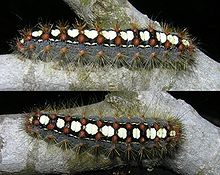Poplar moth
| Poplar moth | ||||||||||||
|---|---|---|---|---|---|---|---|---|---|---|---|---|

Poplar Moth ( Leucoma salicis ) |
||||||||||||
| Systematics | ||||||||||||
|
||||||||||||
| Scientific name | ||||||||||||
| Leucoma salicis | ||||||||||||
| ( Linnaeus , 1758) |
The poplar moth ( Leucoma salicis ) is a butterfly ( moth ) from the subfamily of the bearer moth (Lymantriinae) within the family of the owl butterflies (Noctuidae).
description
The moths reach a wingspan of 37 to 50 millimeters. Her whole body and wings are colored pure white. Only the legs are alternately ringed in black and white. The antennae of the males are long sawed, those of the females are short.
The caterpillars are about 40 millimeters long. They are very vividly colored. The basic color is blue-gray, but this can only be seen on the sides. The back is broadly black in color and has very large, whitish spots that spread between the segments and partly grow together. At the edge between the gray-blue and black color you can see further small whitish spots. In addition, the body is provided with numerous point warts located in the middle of the segments. These are dark red in color, smaller on the sides than on the left and right of the back and have more or less long, light yellow hair.
Similar species
- American weaver ( Hyphantria cunea )
Occurrence
The animals are found in almost all of Europe , but not in the British Isles and in the far north. The species is distributed as far east as Japan . They live in open to partially shaded, slightly damp places, such as B. on forest edges and hedges with their forage plants, but also in avenues, parks and gardens. They are common almost everywhere, but only occur in small numbers. Mass reproductions are also reported, but these are only known from historical times.
Way of life
The nocturnal moths are attracted by artificial light at night. During the day they sit on tree trunks. If you disturb them, they give off a yellowish liquid on the abdomen.
Flight and caterpillar times
The moths fly from June to August, the caterpillars are found from May to June.
Food of the caterpillars
The caterpillars feed on various types of poplar , especially the trembling poplar ( Populus tremula ), but also on willows , such as. B. of goat willow ( Salix caprea ) and Salix viminalis ( Salix viminalis ). But they should also feed on birch , oak and alder .
development
The females lay their eggs in groups of 50 to 80 on the leaves and branches of the forage plants. Then they are coated with a white, foamy secretion that hardens. The caterpillars that hatch from this initially live together and eat while sitting on the underside of the leaf. But they only eat the lower side of the leaf, so that the upper side remains intact. With a size of approx. Three to four millimeters they become loners and start looking for a suitable wintering place. To do this, they build oval webs in the cracks of the bark or between leaves. In the following spring, the caterpillars finish their development and pupate on branches or leaves in a loose, white web. According to Koch, wintering also takes place in the egg. The doll is patterned dark purple and light pink and has bright yellow hair.
swell
Individual evidence
- ↑ a b c d e Heiko Bellmann : The new cosmos butterfly guide. Butterflies, caterpillars and forage plants. Franckh-Kosmos, Stuttgart 2003, ISBN 3-440-09330-1 , p. 292.
- ^ A b Hans-Josef Weidemann, Jochen Köhler: Moths. Weirdos and hawkers. Naturbuch-Verlag, Augsburg 1996, ISBN 3-89440-128-1 , p. 382f.
- ↑ a b c Manfred Koch : We determine butterflies. Volume 2: Bears, Spinners, Swarmers and Drills in Germany. 2nd, expanded edition. Neumann, Radebeul / Berlin 1964, DNB 452481929 , p. 86 f.




